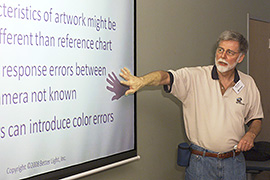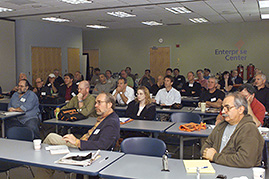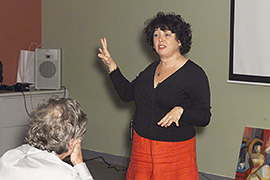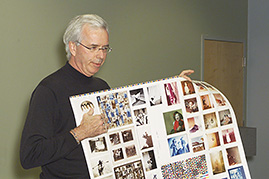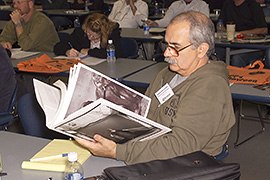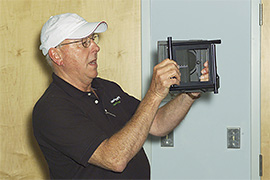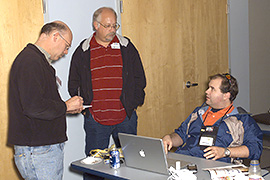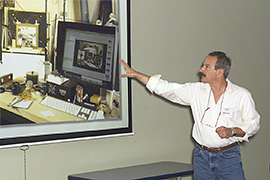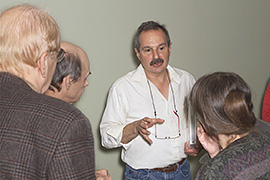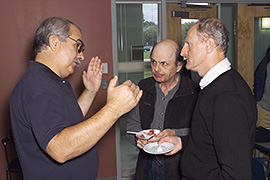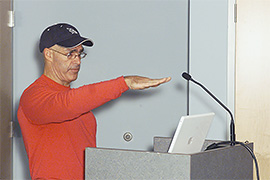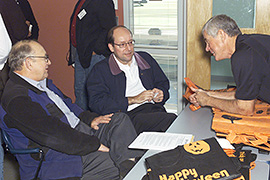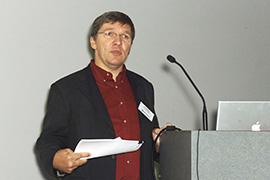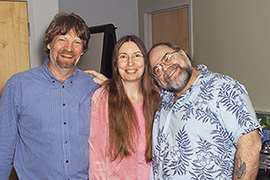
|
BETTER LIGHT'S 7th "Almost Annual" OWNERS CONFERENCE
October 2 – 3, 2008 Location: The Enterprise Center, Salem, MA |
||||||||||||||||||||||||||||||||||
|
Conference Returns to the East Coast It had been six years since we held our Owners Conference on the East Coast and although it was efficient and convenient to hold the “almost annual” meeting at our San Carlos, California offices, the decision was made to go back to the East for 2008. Through our email Forum feedback we had numerous suggestions for a location for the event. After researching transportation, hotels, and venues in several cities, Salem, Massachusetts was selected. A major influence was Ditto Editions, the art reproduction business owned by Susan and Nick Fader. Ditto Editions offices are in The Enterprise Center on the Salem State College Campus and the building had an excellent meeting room that could hold up to 80 people. Salem is about 16 miles North of Boston and has lots of history and charm, as you could imagine. Transportation was convenient for all parts of the country and we could escape the big city hotel prices. And…what better place to have a meeting in October than Salem where witch trials were held in 1692 and now Halloween and witchy whoopla is celebrated throughout the whole month. In keeping with the seasonal festivities, our theme was “Tricks and Treats” encouraging our speakers to share some of their tips and techniques of photography with the scanning back. The 2008 Conference was our 7th event in eight years. Fifty owners from the East Coast and throughout the country joined us for the two-day event. A special “atta-boy” goes to Tony Brownjohn who traveled from New Zealand for his first conference. We had long-time scan back veterans, owners who had attended previous conferences, new users, and even a few who were planning on purchasing in the near future. The programming covered all types of applications from art reproduction to architecture and jewelry to landscapes. From the feedback received from the attendees, the mix was on target…delivering lots of “tricks and treats” to improve scanning skills and providing motivation to try something different. The Owners Conference was never meant to teach photography techniques…it has always been an event to stimulate ideas and encourage people to try something new and make the most of the Better Light scanning back. We’ve inspired architectural photographers to shoot infrared landscapes; tempted commercial product shooters to copy artwork, and encouraged art specialists to try some fine art photography of their own. The following summary of the presentations will give you a little idea of what was discussed, pass on a few “tricks”, and hopefully provide some incentive for you to join us for the next conference. An opening reception on Wednesday evening has become a regular event over the last few years. This year we met in The Hawthorne Hotel’s Tavern to catch up with old friends, meet new owners, and make plans for dinner. About two-dozen people joined Bill Smith of Boston Photo for an authentic New England seafood dinner at the historic Woodman’s Restaurant in nearby Essex. On Thursday morning, the group gathered at The Enterprise Center for the beginning of the conference sessions. As always, Mike Collette, Better Light’s president and founder, got the meeting started with a discussion of the new ColorSage Direct Spectral™ workflow for fine art reproduction. Officially announced at Photokina in Germany just the week before our conference, ColorSage is a new software product from Better Light that is powered by HP Artist Software and combines direct spectrophotometer measurements from the original artwork with the spectral characteristics of the scanning back and light source to generate a spectrally-corrected RGB image for printing. Better Light has worked with Hewlett-Packard engineers for several years as this concept developed. A raw file from the Better Light scanning back is processed with the spectral data, eliminating color reference charts and camera profiling. Non-uniform lighting is also compensated for in ColorSage to make it easy to light for texture of the original. Spectral measurements can be made with an X-Rite i1 Spectrometer or with several non-contact devices. Currently, an HP Z3200 wide format printer is required to run ColorSage, but the profiled files can be output on other printing devices. Click here for more information on ColorSage. The initial response of this new color control workflow was encouraging. The first prints…straight from ColorSage to the printer…were very impressive and it was easy to see how much production labor and materials could be saved. As an extra surprise, Mike showed some of the “Spin-Outs” his son Alex had created over the summer months. Using the table platform on the Pano/WideView™ Adapter and a variety of objects around the studio (rubber bands, clamps, paper clips, broken glass, etc.), Alex created some amazing panoramic format art. The results are nearly impossible to imagine from the original subject matter, but Mike is preparing a web page with some samples images and details of the process to encourage others to try this for themselves. BILL SMITH, Boston Photo, Boston, MA Our first owner to take the podium was Bill Smith who gave us a behind-the-scenes look at his photography of a Garibaldi Panorama double-sided watercolor artwork. Once a “moving” panorama used as public entertainment, it is one of the largest paintings in the world, 4.5 ft. wide x 273 ft. long. Bill and his team photographed the panorama on location at the Brown University Library in six-foot sections. The 91 sectional images, of about 240 MB each, were delivered to the library’s digital imaging department for final processing and assembly of the panorama for public access and the website. The high-resolution scans will allow the viewer to zoom in to image details. The photographic setup included a large Foba camera stand to position the camera above the panorama scroll. Two NorthLight 900-watt HID Copy Lights were used on the sides and four 150-watt Buhl HID lights were used on the corners to compensate for lens falloff. More information on the digitization project can be found at: http://dl.lib.brown.edu/garibaldi/panorama/digitization.html TODD MAY, May’s Photo, Rockland, MA For over ten years, Todd May has operated a total digital studio producing high-end product photography of jewelry, shoes, and fashion accessories for advertising and catalogs. The right tool for the job for much of his work is his 4x5 view camera and the Better Light scanning back. Todd does quite a bit of jewelry and explained how he approaches lighting these products. “It’s all about reflections…you don’t really light the jewelry, you light the object reflecting in the jewelry,” explained Todd. “Just like a game of pool, the ball bounces off of the bumper at the same angle that it was hit from.” Clothing, leather goods and fabric products are also a big part of May’s client base. Todd continued, “The scanning back will seldom cause a moiré pattern, but a Bayer-pattern single shot back will. And, you just can’t beat the intricate detail that the scanning back will capture in my clients’ expensive fabrics and fine leathers.” Todd also feels that he is able to control color of the fabrics and leather better with the scanning back. He will often rely on fluorescent lighting and the “double filter” technique using additional infrared-absorbing filtration to minimize the fabric’s tendency to fluoresce IR and shift to unexpected colors. Other studio and location product photographs were used to demonstrate lighting ideas and how Todd deals with the challenges of each day. ROBERT HENNESSEY, Separations for Offset Printing, Middletown, CT A true specialist in his field, Robert Hennessey has been responsible for the printed reproduction of numerous photographic books for museums and publishers all over the world including “Women in the Mirror”, Photographs by Richard Avedon and “The Art of Perception”, Photographs by Carlton Watkins. Robert believes quality is achieved through control and communication. Whenever possible, he attempts to scan the original photographs himself. That way he can create original digital files that are optimized for the prepress production process. In some cases he must rely on photographers in other parts of the country (or the world) to copy the originals to designated quality specs. Other components of the publication may come to him as transparencies or digital files of varying levels of perfection. A key to the efficient production of the publication is to take steps to assure the most accurate reproduction of the original photographs. This can be a very difficult task since the pages are printed in 8, 16 or more signature forms on the press. Images are divided into groups with quality control patches for a series of adjustments and proofing cycles to correct for any variations and errors prior to going to the press. Communication with all parties from the ultimate client, publisher, and printer is essential to maintain quality, protect the budget and reach everyone’s expectations. TOM WATSON, Tom Watson Photographer, Skaneateles, NY After forty years in photography, Tom Watson has no intention of retiring…he is enjoying a new phase of his photographic career. After years as an annual report and architectural photographer, Tom has now become an accomplished nature photographer and selling his photography as fine art prints. We asked Tom to share some of his ideas on location and landscape photography with his Better Light scanning back which he describes as his “point & think” camera. He feels that the scanning back is much more intellectually engaging than film and gives the patient photographer superior image quality that we could never achieve prior to digital technology. “Shooting outdoors with the scanning back takes a high degree of organization and thought”, Tom explained to the group. “My equipment fits in a backpack or on a rolling hand truck. Everything is packed the same way each time so I know at a glance that every filter and cord is there.” Tom showed some of the special camera accessories that he had made for his panoramic landscape work. He also has created a shelf for the computer that fits over his hand truck handle and another for a tripod mount when backpacking. He uses the Pano/WideView Adapter for much of his work, but also will often do a “wide-view” image by shifting the film back standard to each side for a composite image with less distortion than with a panoramic movement. More about Tom and his work can be found on the Better Light website in the Featured Photographer section. SUSAN FADER, Ditto Editions, Salem, MA Susan Fader and her husband Nick have built an exemplary fine art digital printmaking business. The Faders have used their marketing experience to build a strong client base and take advantage of public relations and self-promotion opportunities. With a strong background in advertising, design, and fine art, Susan has become an advocate of establishing a level of expertise and professionalism within the field. In Susan’s words, “As fine art printers we think it is important to help develop some industry standards. Quality, accurate and archival art reproduction takes knowledgeable professionals who specialize specifically in reproducing fine art using the most up-to-date equipment and methods.” Business concepts are often overlooked in photo industry conferences and Susan was willing to share some of her ideas to build a business and establish a professional reputation. She emphasized the importance to have a goal and direction for your business and then writing the details into a comprehensive business plan. “You have to ‘live’ the plan…just writing it won’t do any good if you don’t execute,” added Susan. Create a marketing schedule and treat each item with the same importance as a customer’s job. Execute, follow-up and track results. Competition is all around us now, some competent and some not. To separate your business as the most qualified, build a strong visual identity with a professionally designed logo, and using that logo and design style on all of your printed materials, packaging, and promotional pieces. Take advantage of every opportunity to expose your business to new prospects and to create a feeling of expertise, professionalism, reliability, and trust. LARRY GUYER, A la Carte Digital Studios, Foster City, CA As previous marketing director for Better Light and having worked as a consultant and trainer, Larry Guyer has seen the bad habits some Better Light users have developed, and recognizes that some of the great features in the ViewFinder™ not known or understood by the photographers. The mathematics of physics and photography are often overlooked and some principals related to f-stops can improve the understanding of many of the ViewFinder controls and other options in optimizing scan quality. F-stops are a unit of measurement equal to a factor of two or one-half. This same unit can be used with camera lens openings, Line Time and ISO settings, and light intensity to determine the most favorable scanning conditions. Additional tips, tricks, buttons and options of ViewFinder software were reviewed that are often overlooked or may not have even been used to their full advantage. Larry has just completed an updated version of the ViewFinder tutorial which can be downloaded from the Better Light website. BEN BLACKWELL, Ben Blackwell Photography, Alameda, CA Ben Blackwell has spent his entire photographic career photographing art for museums, libraries, galleries and artists. “You would think by now, I would know exactly how to light any type of artwork”, Ben stated as he began his program, “But every piece and every situation has some unique character that just cannot be fit into a standard procedure”. The most important thing is to be able to “see light” and Ben has always had a great respect for the late Dean Collins, a talented photographer and popular educator, who summarized the concepts of lighting in a program called “3-Dimensional Contrast”, now sold on DVD at www.software-cinema.com. “It doesn’t matter what you use for the light source as much as seeing what it does to your subject and understanding what can be done to achieve the results you are looking for,” Ben explained. Any type of light source, ambient light, diffusers, reflectors, and multiple exposures are all tools available to the photographer to accomplish the task at hand. He reinforced these concepts by showing a wide variety of art that he has had to photograph – all sizes, many types of media, and under all types of obstacles on location. JACK NEITH, JDN Photography, Inc., Shamong, NJ A lot has changed for Jack Neith in the past year. As a successful architectural photography, Jack traveled all over the country creating photographs for national magazines, trade journals and manufacturers. He and his wife, Oleta, worked with Schiffer Publishing, Ltd. to publish two books of his architectural photography. “Power Rooms”, was a collection of over 200 notable executive offices, corporate lobbies and conference rooms. Another book of kitchens was just released this fall. Jack talked about the benefits of working with the scanning back in a variety of architectural projects, describing how the ability to composite images digitally greatly improves the quality and efficiency of working on location. “No more filtering of windows and changing bulbs in light fixtures… by using the benefits of large format digital, I can be more efficient and the results are better than I could get with film”, Jack stated. Like other facets of the photo industry, the architecture industry has changed and the demand for new photos and budgets continued to decline. He saw an opportunity that he couldn’t pass up with eFashions.com to become Director of Photo Studio Operations. Although this new fashion business is fast-paced production work, Jack has already found a role for the scanning back. He showed some early tests of object movies of Judith Leiber handbags created with the Better Light Pano/WideView™ Adapter and turntable. The expensive jeweled handbags can be shown from all sides and enlarged for close-up detail to enhance the online shopping experience. TOM GRASSI, Image-Tec, Metheun, MA A commercial “generalist”, Tom Grassi has been a Better Light owner for eight years and uses the scanning back for all types of work, including cars, food, catalog, and art reproduction assignments. He loves working with his 4x5 large format camera and most of the subject matter that he photographs requires the camera controls for plane of focus, distortion control, and perspective correction. The Better Light provides the file resolution that gives him a competitive edge with superb rendering of detail and large output capability. Tom highly encourages the use of a sturdy camera stand in the studio such as a Foba or Cambo rather than a tripod for the stability and versatility to shoot low to the floor, high angles, or straight down with the same piece of equipment. Most all of his work is in the studio. Tom has a large studio with a cyc wall, kitchen and overhead rail system to help him handle a wide variety of work quickly and efficiently. Since he has the space available, he is able to have an area of the studio setup for copying artwork. He had experimented with a number of lighting techniques to create a system for copying most any type of original art without the need for polarization. A diffused light source from high above minimizes any glare and still provides a directional light that captures all of the texture of the original art. See Conference Tips page for more details. JIM MORRIS, Morris Editions, Silver Spring, MD To wrap up this year’s conference, we invited Jim Morris back for another presentation. He has been one of our most enthusiastic and talented speakers in years past and again informed and inspired the group. Jim has recently been added as a “featured photographer” on the Better Light website, featuring his jewelry, architecture and landscape photography. His work is outstanding technically, and yet his unedited curiosity drives his creativity in his commercial and personal work. He credits previous Owners Conference speakers for stimulating his purchase of the pano adapter and his experimentation with infrared landscape photography. Jim is a free thinker, a problem solver, and driven to understand how to use technology to improve his photography. As a result, his images continue to be innovative and creative visual imagery. “The more one experiments, the more one learns – and the more one learns, the greater the number of options, Jim added.” His presentation took us through a series of images with Jim’s unique sense of humor highlighting the back-story of what it took to solve the challenges of each assignment. “Accepting challenges is what makes photography fun…for me, at least,” Jim emphasized. “If you only accepted jobs with canned solutions, the results would always be the same, and then the work becomes stale and boring”. IN CLOSING… We are all very fortunate to be making a living in a creative business such as photography. There is no reason that we can’t have fun doing what we love and get the additional satisfaction of producing something uniquely creative. Jim Morris is a perfect example of this life model specifically, but it is also easy to see that so many of our Better Light users are extremely talented and yet so interesting in learning and sharing ideas to improve their work and elevate their creative satisfaction. The Better Light owners are a unique family, unlike any I have seen in any other trade relationship – so much talent, friendship and unselfishness within the group. I want to again thank all of our speakers on behalf of everyone at Better Light and all of our attendees at the Salem Conference. It is a pleasure to be part of producing this “almost-annual” event. I look forward to seeing you all again next time!
Next year…get your reservations in early and join us for a great experience.
2009 Conference – "A Politive Influence in a Tough Economy" 2007 Conference – "It's Not Easy...But, It's Worth It!" 2006 Conference – The Hottest Ever 2006 Post-Conference Field Trip 2005 Conference Emphasizes Varied Applications 2002 Conference Followed Photo Expo East
Copyright 2007-09 Better Light, Inc. All Rights Reserved.
|
|
|||||||||||||||||||||||||||||||||
